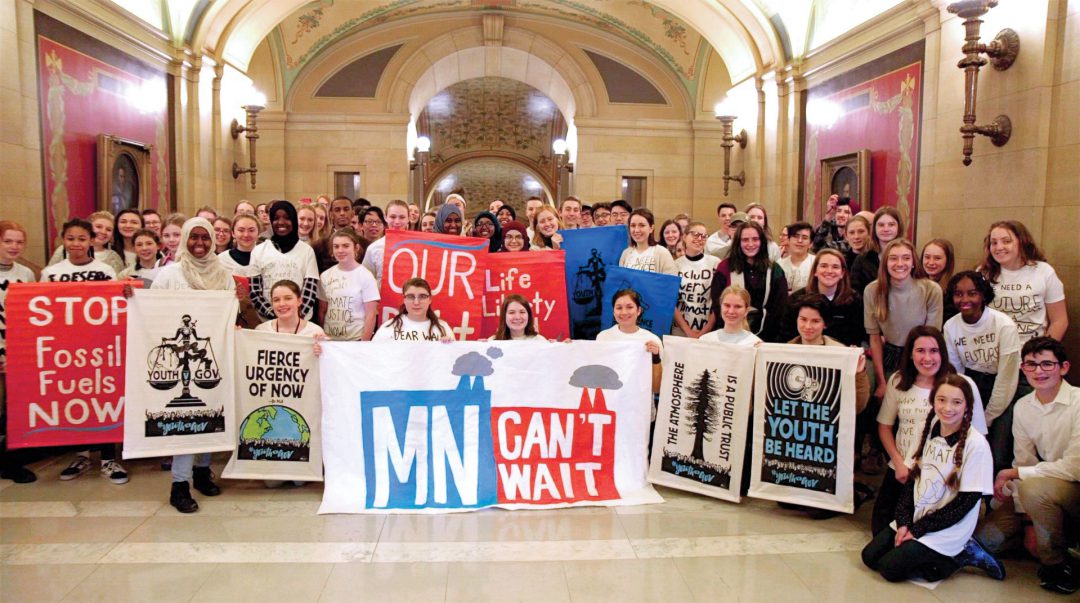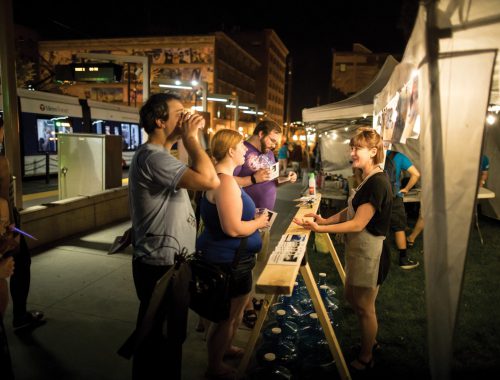
The Environment Can’t Wait
Gabriel Kaplan wants to bring the Green New Deal to Minnesota.
Most of 16-year-old Gabriel Kaplan’s extracurriculars are typical for what you might expect from a high school sophomore. He likes to spend time with his friends, go for runs and play with his golden retriever. But between social engagements and studying for European history exams, Kaplan is busy taking hour-long phone calls and meeting with politicians to advocate for climate-conscious policy with a statewide, student-led organization called MN Can’t Wait. At present, one of the biggest tasks on the organization’s plate is an effort to bring local attention to the Green New Deal.
The national Green New Deal, as proposed by Rep. Alexandria Ocasio-Cortez (D-NY), calls for mobilization across the nation to reduce both the environmental and social impacts of climate change over the coming decade. Goals of the Green New Deal include meeting 100 percent of the U.S. power demand through renewable, zero-emission energy sources; reducing current pollution using low-tech solutions like restoring natural ecosystems; and providing healthcare, higher education, a fair living wage and affordable housing for all U.S. citizens. The deal also tackles social justice issues in its goal to stop and prevent the oppression of historically underrepresented and marginalized communities.
Inspired by Ocasio-Cortez’s vision, Kaplan and MN Can’t Wait created a Minnesota Green New Deal and presented it to lawmakers at the State Capitol. We talked to Kaplan about the plan, whether or not it can succeed, and what it would mean for the environment.
What is the Minnesota Green New Deal?
The Minnesota Green New Deal is very similar to the national one in a lot of ways, but we also modified it a fair amount to make it fit best for Minnesota. We turned the resolution, which Ocasio-Cortez introduced into Congress, into a bill, which means it has more power if it were to be passed.

It does more than just say things like a resolution does. The main focus is transitioning Minnesota into a green future, and a sustainable one. And we can do that while keeping a social justice aspect in mind and making sure that no communities are left behind in the transition to that green future. It’s important that historically marginalized and underrepresented groups are included in the process and discussion surrounding the transition.
What would the Minnesota Green New Deal mean for Minnesota?
If it were to be passed, it would ensure that Minnesota transitions to 100 percent carbon neutral electricity by 2030. It also establishes some government offices to ensure the transition is done so that no communities are harmed by it. There are also other aspects like making sure that there isn’t a ton of new fossil fuel infrastructure, so I think overall, the goal is to change what’s politically possible with this bill. There are other ambitious environmental and social components, the main one being to transition away from fossil fuels at a statewide level. To go along with that, there are social policies to help marginalized and underrepresented communities, as well as those that are deeply connected to fossil fuels and making sure those people are not left behind by the transition.
How optimistic do you feel about the bill being passed?
We’ve been working with Rep. Frank Hornstein (DFL-District 61A) and Sen. Scott Dibble (DFL-District 61), who are both really great and helped us a lot with forming the bill and with other aspects of our organizing. Many members of the state legislature are not as aggressive on the issue of climate change.
Although we are a nonpartisan group, some politicians have made climate change into a partisan issue, which it shouldn’t be. That’s why our goal this year is not necessarily to actually pass a bill, but rather to start a discussion around it and hopefully make it so that all Minnesotans recognize the threat of climate change, regardless of whether they’re Democrat or Republican or Independent or anything else.
The organization behind the Minnesota Green New Deal is called “MN Can’t Wait.” What is it that we can’t wait for?
Just like all 50 states and all countries on the planet, Minnesota can’t wait for action because we’re already starting to feel the effects of climate change. If we don’t act now, and if others across the country and the planet don’t act, those effects are only going to get worse. So we need to act now to ensure the future is not ruined by this potential crisis.
How did you get your start with MN Can’t Wait?
I first got involved after learning about climate change. I think like many other climate activists and many other young people, I started to get very overwhelmed by the issue because it’s such a big thing. And it often seems like we can’t actually do anything to make a difference and to chip away at it. But as soon as I joined the youth climate movement, I started to realize that we can actually make a difference even if it’s just on a local or statewide level. Because if we don’t start there, we’re never going to get anything done.
Fighting climate change can feel like an impossible battle. What keeps you going?
I think, honestly, the other youth activists in the group are what keep me going. Because when we started out last August, we had maybe around 10 people, and now we have over 100 organizers in the group. It’s been really inspiring to see all the people joining and being passionate about it.
Photo Credit: Devon Cupery










